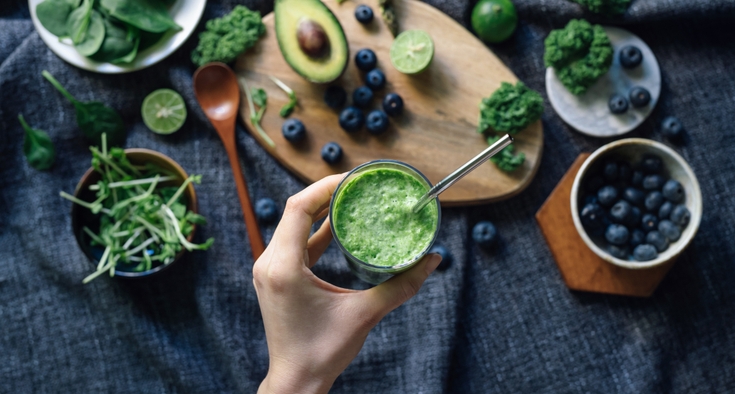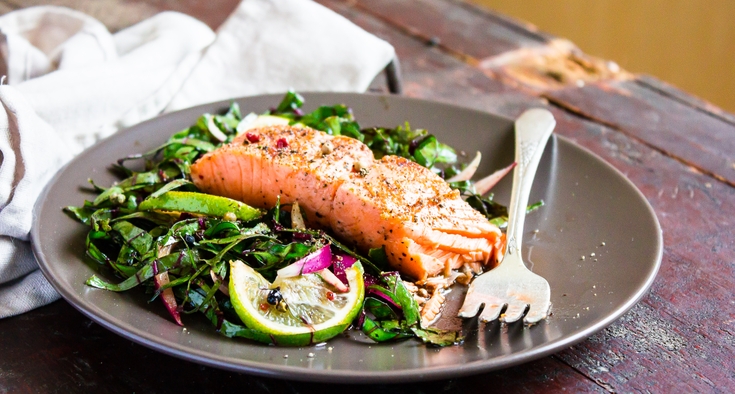It’s one of the best-known rules for a healthy life and … one of the least-followed: Eat lots of vegetables.
For many reasons — taste preferences, time pressures and budget constraints — getting enough vegetables can be a challenge. So if your idea of misery involves a plate of cabbage and beets, the trendy greens powders veggie supplements may look alluring. And sales are growing fast as American consumers search for the next easy fix.

“They’re especially appealing to those among us who don’t care for the flavors or textures of greens and other vegetables,” said Sara Parrish, a wellness dietitian at Novant Health New Hanover Regional Medical Center’s Team Member Fitness Center. “People are also attracted by the idea of convenience — getting their veggies by simply adding a powder to their morning smoothie.”
In addition to delivering a daily dose of fruits and veg, many of these supplements also claim to enhance immunity, aid in detoxification, heal the gut and boost energy. But do they deliver on their promises?
On that front, there’s relatively little research back up health claims of these unregulated powders. They can also be expensive.
To help you decide if greens powders are right for you, we asked Parrish — who provides wellness programming and one-on-one nutrition counseling for Novant team members and their dependents — about potential benefits and risks. Read on for her answers, and don’t miss her great tips for easily adding more fresh produce to your day.
Sick? You've got our 24-hour guarantee.
What’s in greens powders?
The ingredients vary from brand to brand, but most powdered greens are made from a variety of freeze-dried, ground vegetables and fruits, which often include:
- Broccoli, beets, carrots and other vegetables.
- Greens like kale, spinach, collard greens.
- Grasses, including wheatgrass, barley grass, alfalfa.
- Various types of seaweeds.
- High-antioxidant fruits, like blueberries.
Some products are also fortified with vitamins and minerals and may include probiotics and prebiotics in an effort to promote gut health.
In terms of flavor, they have an earthy or grassy taste that some people may find a bit bitter. Some brands emphasize milder vegetables, include more fruit or add a sweetener like stevia in an effort to improve the taste. Nevertheless, most people prefer to blend greens powders into a morning smoothie (check out the recipe below) or flavorful dishes like chili to conceal their flavor.
We’re here to help with weight
Struggling to lose weight? Want help with healthier eating? Or maybe you need a hand with Type 2 diabetes? Novant Health doctors and other specialized clinicians are ready to help.
- CoreLife: CoreLife Novant Health offers you a way to get to a healthy weight and address medical conditions that keep you from living the life you want.
- Bariatrics and weight-loss surgery: Click here to reach team members who will contact you to discuss your needs or schedule an appointment.
- Registered dietitians help us make smart choices. Find one today.
- Diabetes: Whether you are trying to prevent diabetes, learning how to live with it, Novant Health is here to help.
- Primary care clinicians: Not sure where to start? Schedule an appointment to begin the journey.
Are powdered greens good for you?
It’s no secret that eating a diet rich in vegetables and fruits helps our bodies function while preventing cardiovascular disease, Type 2 diabetes, cancer, Alzheimer’s disease and other chronic conditions.
However, only about 10% of the U.S. population meets the current recommendation for vegetables, according to the U.S. Centers for Disease Control and Prevention. The amounts vary by age, but for most adults the Dietary Guidelines for Americans recommends at least 2 1/2 cups of vegetables per day.
So, if you’re really struggling to get enough variety in your diet, a greens powder could provide a nutritional boost. But I encourage my clients to choose whole foods over supplements, to ensure you’re not missing out on the fiber, phytonutrients, vitamins and minerals present in their natural form.
Will it help detox my body?
There’s a lot of buzz on the internet about diets and supplements that promise to help detoxify our bodies. But in truth, our bodies are already very smart about removing unwanted substances.
Organs like the liver and kidneys filter out anything our bodies can’t use, so there’s really no need to worry about “detoxing.” All we really need is to take good care of our bodies — stay hydrated, eat a balanced diet, get plenty of sleep — and they’ll take care of the rest.
In fact, using greens powders or other supplements in an effort to detox can backfire. These products are not regulated by the Food and Drug Administration, and manufacturers are not required to be transparent about the ingredients. And in some cases, they may even contain hidden allergens or heavy metals like lead.
Who should not use powdered greens?
Greens powders are generally safe for most people — though the ingredients may promote temporary bloating or digestive upset. But if you have a severe food allergy or are concerned about consuming any ingredients that might not appear on the label, I’d suggest focusing on eating a healthy, whole foods diet that contains lots of colorful produce.
Also, powdered greens are not recommended for people taking blood thinners, including heparin and warfarin. These supplements deliver a large dose of vitamin K in each serving, which can interfere with these medications. That’s why it’s really important to check with your doctor before starting any new supplements.
Bottom line: So while they may be harmless for most people, getting your vegetables the old-fashioned way — by eating whole foods — will be both healthier and more cost-effective.
Six easy ways to start eating more vegetables
“Our bodies are designed to absorb the nutrients we need from real, unprocessed fruits and vegetables,” said Sara Parrish, a wellness dietitian at Novant Health New Hanover Regional Medical Center. “So I encourage my clients to focus on whole food sources as much as possible.”
To help make that easier, she offered the following tips:
- Start your day strong by adding veggies to breakfast. Blend a handful of raw baby spinach into your smoothie, mix broccoli from last night’s dinner into an omelet, or sip a glass of low-sodium, 100% vegetable juice.
- Pack a snack of raw veggies — carrots, cucumber spears, broccoli or cauliflower florets, red bell peppers, etc. — with a single-serve container of hummus for a healthier alternative to fast food when you’re out and about.
- Supercharge lunchtime sandwiches with sliced cucumbers, bell peppers, baby spinach or romaine lettuce, tomatoes and thinly sliced onions.
- Get creative when making spaghetti sauce, chili, soups or stews. Add in zucchini, shredded carrots, baby spinach leaves, sliced mushrooms, bell peppers and other veggies.
- Be creative when making salads. Try adding: Shredded beets, radishes, chopped raw broccoli and cauliflower florets, shaved Brussels sprouts, colorful bell peppers and some hearty greens (finely chopped kale, collard, chard, etc.
Recipe
Greens-boosted blueberry-banana PB smoothie
1 medium banana
1/2 cup fat-free plain Greek yogurt
1/2 cup plain unsweetened almond milk
2/3 cup unsweetened frozen blueberries
2 tablespoons PB2 powder* (or 1/2 tablespoon peanut butter)
1 serving greens powder of your choice (check label for exact amount)
1/2 cup ice
Preparation:
Put everything in a blender, cover and blend until smooth. Pour into a tall glass and enjoy!
Nutrition per serving (recipe yields 1 tall glass): 236 calories; 48.5 grams carbohydrates (26.5 grams sugars, 8 grams dietary fiber); 13 grams protein; 4 grams fat; 212 milligrams sodium.
*Note: PB2 is a roasted peanut powder, made with roasted peanuts, salt and sugar. Two tablespoons contain only 1.5 grams of fat. To make it into peanut butter, you simply add a little water.












